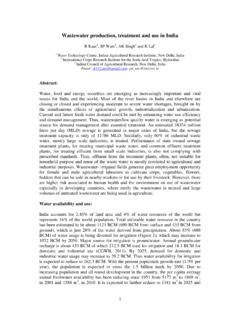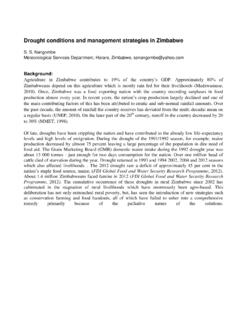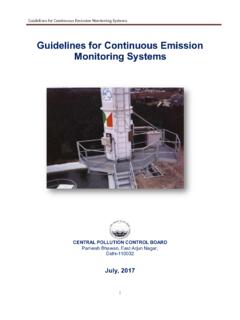Transcription of Wastewater Production, Treatment, and Use in India
1 1 Wastewater production, treatment and use in India R Kaur1, SP Wani2, AK Singh3 and K Lal1 1 Water Technology Centre, Indian Agricultural Research Institute, New Delhi, India 2 International Crops Research Institute for the Semi-Arid Tropics, Hyderabad 3 Indian Council of Agricultural Research, New Delhi, India Email: Abstract: Water, food and energy securities are emerging as increasingly important and vital issues for India and the world. Most of the river basins in India and elsewhere are closing or closed and experiencing moderate to severe water shortages, brought on by the simultaneous effects of agricultural growth, industrialization and urbanization.
2 Current and future fresh water demand could be met by enhancing water use efficiency and demand management. Thus, Wastewater /low quality water is emerging as potential source for demand management after essential treatment. An estimated 38354 million litres per day (MLD) sewage is generated in major cities of India , but the sewage treatment capacity is only of 11786 MLD. Similarly, only 60% of industrial waste water, mostly large scale industries, is treated. Performance of state owned sewage treatment plants, for treating municipal waste water, and common effluent treatment plants, for treating effluent from small scale industries, is also not complying with prescribed standards.
3 Thus, effluent from the treatment plants, often, not suitable for household purpose and reuse of the waste water is mostly restricted to agricultural and industrial purposes. Wastewater - irrigated fields generate great employment opportunity for female and male agricultural labourers to cultivate crops, vegetables, flowers, fodders that can be sold in nearby markets or for use by their livestock. However, there are higher risk associated to human health and the environment on use of Wastewater especially in developing countries, where rarely the Wastewater is treated and large volumes of untreated Wastewater are being used in agriculture.
4 Water availability and use: India accounts for of land area and 4% of water resources of the world but represents 16% of the world population. Total utilizable water resource in the country has been estimated to be about 1123 BCM (690 BCM from surface and 433 BCM from ground), which is just 28% of the water derived from precipitation. About 85% (688 BCM) of water usage is being diverted for irrigation (Figure 1), which may increase to 1072 BCM by 2050. Major source for irrigation is groundwater. Annual groundwater recharge is about 433 BCM of which BCM used for irrigation and BCM for domestic and industrial use (CGWB, 2011).
5 By 2025, demand for domestic and industrial water usage may increase to BCM. Thus water availability for irrigation is expected to reduce to BCM. With the present population growth-rate ( per year), the population is expected to cross the billion mark by 2050. Due to increasing population and all round development in the country, the per capita average annual freshwater availability has been reducing since 1951 from 5177 m3 to 1869 m3, in 2001 and 1588 m3, in 2010. It is expected to further reduce to 1341 m3 in 2025 and 2 1140 m3 in 2050. Hence, there is an urgent need for efficient water resource management through enhanced water use efficiency and waste water recycling.
6 Figure 1: Projected water demand by different sectors (CWC, 2010) Wastewater production and treatment: With rapid expansion of cities and domestic water supply, quantity of gray/ Wastewater is increasing in the same proportion. As per CPHEEO estimates about 70-80% of total water supplied for domestic use gets generated as Wastewater . The per capita Wastewater generation by the class-I cities and class-II towns, representing 72% of urban population in India , has been estimated to be around 98 lpcd while that from the National Capital Territory-Delhi alone (discharging 3,663 mld of wastewaters, 61% of which is treated) is over 220 lpcd (CPCB, 1999).
7 As per CPCB estimates, the total Wastewater generation from Class I cities (498) and Class II (410) towns in the country is around 35,558 and 2,696 MLD respectively. While, the installed sewage treatment capacity is just 11,553 and 233 MLD, respectively (Figure 2) thereby leading to a gap of 26,468 MLD in sewage treatment capacity. Maharashtra, Delhi, Uttar Pradesh, West Bengal and Gujarat are the major contributors of Wastewater (63%; CPCB, 2007a). Further, as per the UNESCO and WWAP (2006) estimates (Van-Rooijen et al., 2008), the industrial water use productivity of India (IWP, in billion constant 1995 US$ per m3) is the lowest ( just ) and about 1/30th of that for Japan and Republic of Korea.
8 It is projected that by 2050, about BCM (132 billion litres per day) of wastewaters (with a potential to meet of the total irrigation water demand) would be generated thereby further widening this gap (Bhardwaj, 2005). Thus, overall analysis of water resources indicates that in coming years, there will be a twin edged problem to deal with reduced fresh water availability and increased Wastewater generation due to increased population and industrialization. In India , there are 234-Sewage Water Treatment plants (STPs). Most of these were developed under various river action plans (from 1978-79 onwards) and are located in (just 5% of) cities/ towns along the banks of major rivers (CPCB, 2005a).
9 In class-I cities, oxidation pond or Activated sludge process is the most commonly employed IrrigationDrinkingwaterIndustryEnergyOth er02004006008001000120010729106881027356 632312130155807252 Water usageProjected demand (BCM)YearIrrigationDrinking waterIndustryEnergyOther3 technology, covering of total installed capacity. This is followed by Up-flow Anaerobic Sludge Blanket technology, covering 26% of total installed capacity. Series of Waste Stabilization Ponds technology is also employed in 28% of the plants, though its combined capacity is only A recent World Bank Report (Shuval et al. 1986) came out strongly in favour of stabilization ponds as the most suitable Wastewater treatment system in developing countries, where land is often available at reasonable opportunity cost and skilled labour is in short supply.
10 Figure 2: Sewage generation and treatment capacity in 498 Class I cities and 410 class II towns in India . (CPCB, 2009) Apart from domestic sewage, about 13468 MLD of Wastewater is generated by industries of which only 60% is treated. In case of small scale industries that may not afford cost of waste water treatment plant, Common Effluent Treatment Plants (CETP) has been set-up for cluster of small scale industries (CPCB, 2005b). The treatment methods adapted in these plants are dissolved air floatation, dual media filter, activated carbon filter, sand filtration and tank stabilization, flash mixer, clariflocculator, secondary clarifiers and Sludge drying beds, etc.









